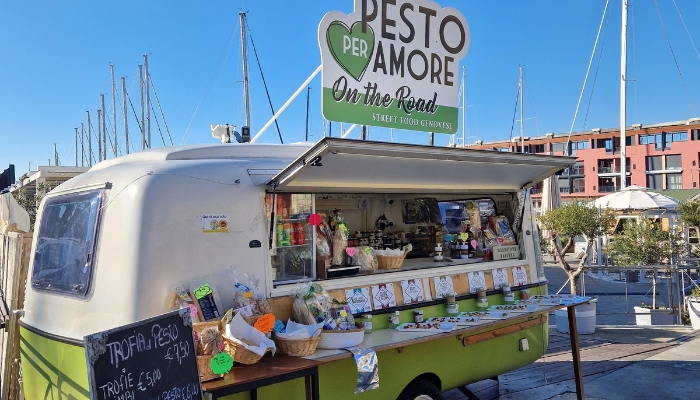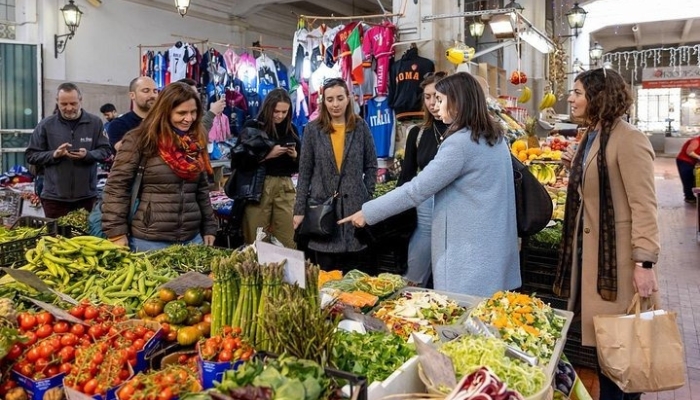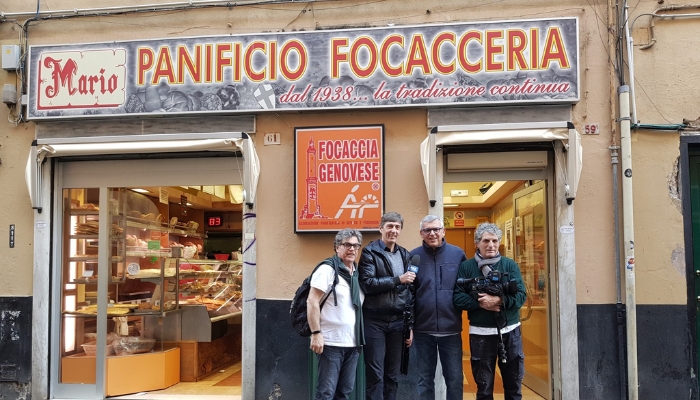
Local Michelin-starred chef Ivano Ricchebono introduces our writer to the flavors of the Italian port city, from fluffy focaccia to creamy pànera
Genoa-born chef Ivano Ricchebono resembles a Hollywood actor portraying a chef in a movie. His restaurant, The Cook, is housed in a 14th-century palazzo in the old town. Stepping into the dining room, I am struck by the sight – the entire place is adorned with frescoes, creating a wildly romantic atmosphere. “People get engaged here all the time,” Ivano remarks with a smile. Awarded his first Michelin star in 2010, he has cooked for Stanley Tucci and enjoys an international reputation for excellence. Today, however, he is my guide, not to the burgeoning fine dining scene, but to the affordable (and equally delicious) fare enjoyed by locals every day.
Once a mandatory stop on the 19th-century Grand Tour and known as “La Superba,” the center of Genoa is replete with impressive architecture that speaks to this underrated port city’s past as a rich and powerful republic. Situated between the sea and the Ligurian Alps, it’s just an hour and a half by fast train from Milan and about the same distance to the Cinque Terre. Among Italians, the city is renowned for its culinary riches – almost everyone agrees that the pesto and focaccia here are the best in the country (there’s even a focaccia festival in May). Our plan is to stroll through several neighborhoods and sample as many of Genoa’s gastronomic delights as possible.
Ivano doesn’t speak much English, and my Italian is terrible, so I bring along Maria, a friend’s daughter, to translate. Our first stop, in the medieval heart of town, is at a tiny hole-in-the-wall cafe, Cremeria Buonafede. This is the best place for pànera, a particularly dense sweet cream invented in the city in the 19th century. Ivano orders a caffè con pànera, an espresso topped with a ridiculous amount of the stuff, dusted with a choice of cinnamon or cocoa powder. I have a semifreddo, a kind of pànera that’s like soft, coffee-flavored ice cream. It feels pretty decadent for 10 a.m., but then the smart older Italian couple at the bar next to us are breakfasting on maritozzi, brioche buns stuffed with an unreasonable amount of cream.
Traditionally, when they’re not enjoying pànera, people in Genoa eat focaccia for breakfast, often dipping it into their morning cappuccino

We walk off (some of) the calories as we continue through the tangle of streets and almost impossibly tiny alleys called vicoli. Streets have poetic names such as Piazza dell’Amor Perfetto (perfect love). Via Giuseppe Garibaldi is lined with palazzos built by the Genoese aristocracy during the Renaissance. “The noble families were all competing to build the most beautiful palaces,” says Ivano (they’re open to the public on certain days, known as “Rolli days”; the next ones are on 17-19 May; the newly reopened Palazzo Rosso is now a museum, open Tues-Sun, €9).
We head west towards the port. Genoa constantly reminds you it’s a place where real people live, not a picture-postcard museum of the past. At Piazza San Giorgio, on the boundary between the old town and the seafront, we stop at Friggitoria San Giorgio, which sells bright yellow cones of fried fish to take away. The fish comes fresh off the boats at 7am every day, and it’s no ordinary selection: there are anchovies fried in chickpea flour; calamari and octopus; to be eaten on a bench overlooking the sea. They haven’t started frying when we arrive, so I take Ivano’s word for the quality of the food, and we keep walking.
Further along the street, under the arches, is the retro shopfront of Gran Ristoro, a great place to pick up a panino. An enormous selection of hyperlocal ingredients sits in the window alongside foods from other Italian regions. Ivano points out his go-to: cima alla genovese, slow-cooked breast of veal stuffed with vegetables and eggs and cut into slices; aged pecorino cheese; and salsa verde, made with parsley, garlic, and olives. As we walk on, we pass Pescheria da Simone, the stall where Ivano sources all the fish for his restaurants. “It’s the best,” he says.
At the market, we admire sculptural artichokes; dark green zucchini, each adorned with a delicate orange flower; and spices that could rival those found in a Moroccan souk

But perhaps more than anything, Genoa is renowned in Italy for its pesto. The basil plants that grow in the hills of Liguria are particularly special, with smaller leaves and a more delicate flavor. When I ask Ivano where we should go to try some, he passionately asserts, “I make the best pesto!” However, he also recommends Osteria da Pippo, located in the village of Fontanegli, about half an hour away in the hills to the north. Tubs of ready-made fresh pesto can be purchased from delis and from the covered market, as detailed below. Traditionally, pesto is served with small twisted pasta called trofie.
We proceed toward the heart of Genoa, passing the strikingly monochromatic San Lorenzo Cathedral and arriving at the central Piazza de Ferrari. From there, we follow the main shopping street, Via XX Settembre, toward the historic food market, Mercato Orientale Genova (known as MOG). Along the way, I frequently pause to admire the city’s grandeur. Evidence of its affluent banking heritage is ubiquitous – the buildings are elaborate, the fountains magnificent, and the streets are colonnaded. Beneath my feet, there are orange mosaics depicting waves, flowers, and peculiar sea creatures in intricate repeating patterns.
We veer left into MOG, and suddenly, there’s a burst of color and bustling activity. “Here you can find anything you want: meat, fish, vegetables, every single spice you can think of,” Ivano explains, leading me towards Rela, one of the oldest vegetable stalls. We admire sculptural artichokes, dark green zucchinis, each adorned with a delicate orange flower, and spices that would rival those of a Moroccan souk. A peculiar black vegetable, resembling a slightly decayed carrot, catches my eye: it’s scorzonera, or salsify. Ivano explains that it’s one of the ingredients in cappon magro, a traditional Christmas Eve salad of seafood and vegetables.
In the central atrium, bathed in light, diners are enjoying street food. Ivano guides me to Laboratorio Gastronomico, known for its sandwiches, pizza, and a variety of fried treats. Among my favorites are the latte dolce (a thick egg custard cut into squares and deep-fried) and the stuffed zucchini flowers, though the fried ravioli feels like a bit too much indulgence. Other specialties include torta pasqualina, a flaky pastry pie filled with egg, spinach, and ricotta, and farinata, the famous chickpea pancake from Genoa made in large, flat pans.
Ivano then suggests we try some local wines from La Vineria, a wine shop across the atrium. I’m impressed by a fresh, light sparkling Ligurian vermentino, which I find far nicer than prosecco.
No food tour of Genoa would be complete without trying some focaccia. Traditionally, Genoese eat focaccia for breakfast, dipping it into their morning cappuccino when they’re not enjoying pànera. At Panificio Mario, near Brignole station, the bread comes in four varieties: normale (salt), onion, cheese, and sage. It’s pulled out in huge, thin slabs, hot from the oven. Ivano chooses onion, and I opt for the simple salt one, which tastes surprisingly delicate. However, given the day we’ve had, I can’t finish my enormous piece.



